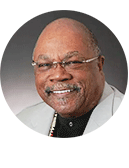
The Jackson Home
The Jackson Home: A Symbol of Courage and Strategy
The Jackson Home, now more than 100 years old, is a unique time capsule documenting one of the most momentous movements in U.S. history: the Selma to Montgomery marches — a sustained effort to ensure that all Americans would have the civil rights and voting rights promised to them.
The Jackson Home is one of several important landmarks of Selma's role in the Long Civil Rights Movement. Dr. Sullivan Jackson and Mrs. Richie Jean Sherrod opened their home to close friend Dr. Martin Luther King Jr. and his allies in Dallas County, Alabama and nationally as a place to rest and strategize the path forward to secure voting rights for African Americans. Voting rights had already been a major focus for local movement leaders like Amelia Boynton, the Rev. Dr. Frederick D. Reese, and the Dallas County Voters League, who had been organizing around the issue for decades. National groups like the Student Nonviolent Coordinating Committee and later Southern Christian Leadership Conference helped to bring international attention to Selma and the effort to register Black voters. From this home's living room, key moments of the Selma Voting Rights Movement were planned, including the Selma to Montgomery March and the Voting Rights Act. Hundreds of people came through the home, including Nobel Peace Prize winners, international dignitaries, media representatives, and activists and supporters of Civil Rights for all. This activism led to the passing of the Voting Rights Act in June 1965.
Major Points in the Long Civil Rights Movement up to 1965
- 1954: Brown v. Board of Education of Topeka, KS
- 1955: Montgomery, AL, Bus Boycott
- 1957: Integration of Little Rock Central High School
- 1960: Greensboro Four and the Woolworth Sit-ins
- 1961: Freedom Rides throughout the South begin
- 1963: Birmingham Campaign and the Children's Crusade
- 1963: March on Washington for Jobs and Freedom
- 1964: Civil Rights Act of 1964
 | "The Henry Ford is magnifying not just Dr. King’s dream to show where he actually laid out a plan to inspire future generations to continue their march towards justice, voting rights, and civil rights. This move is more than the preservation of a house showing where Dr. King worked and strategized. It is the continuation of a movement demonstrating very clearly that the determination of a people can never be marginalized." |

"The home of Dr. Sullivan Jackson and his wife Richie Jean recently pictured in its original location at 1416 Lapsley Ave., Selma, Alabama."

Jawana Jackson, CEO of The Sullivan and Richie Jean Sherrod Jackson Foundation and Museum and steward of the Jackson House, stands in front of a picture of her parents -- friends of Dr. Martin Luther King Jr.







